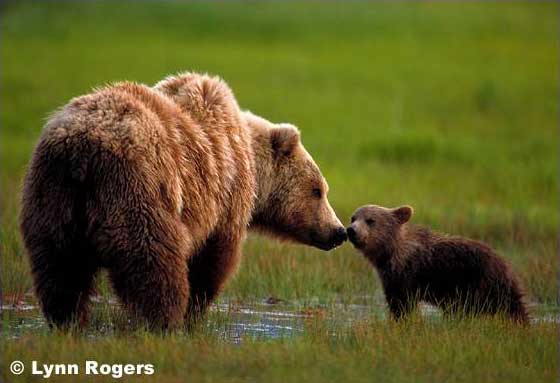
The grizzly bear is a large predator that is different from black bears due to a distinctive hump on its shoulders. Grizzly bears have concave faces and long claws about the length of a human finger. Their coloration is usually darkish brown but can vary from very light cream to black. The long guard hairs on their backs and shoulders often have white tips and give the bears a "grizzled" appearance, hence the name "grizzly." The correct scientific name for the species is “brown bear”, but only coastal bears in Alaska and Canada are referred to as such, while inland bears and those found in the lower 48 states are called grizzly bears.
Height 3- 3 ½ feet at shoulders
Length 6-7 feet
Weight Adult males 300 - 850 lbs; females 200 - 450 lbs
Top speed 35 mph
Lifespan 20 - 25 years
Diet
Omnivorous and will eat both vegetation and animals. Grasses, sedges, roots, berries, insects, fish, carrion and small and large mammals.
In some areas they eat moose, caribou and elk, in others they eat salmon. Grizzly bear diet varies depending on what foods are available in that particular season.
Population
Historically, there were around 50,000 grizzly bears in North America. Today, there are 1,000 - 1,200 grizzly bears remaining in five separate populations in the lower 48 states. In Alaska, there are thought to be over 30,000 grizzly bears.
Range
Grizzly bears are found in a variety of habitats, from dense forests, to subalpine meadows and arctic tundra. In North America, grizzly bears are found in western Canada, Alaska, Wyoming, Montana, Idaho, and Washington. Historically, they could be found from Alaska to Mexico, California to Ohio. The grizzly bear was once common on the Great Plains. However, human encroachment has forced the remaining brown bear populations to move to rugged mountains and remote forests that are undisturbed by humans.
Behavior
Bears live solitary lives except during breeding, cub rearing, and in areas with a super-abundant food supply such as salmon streams. Grizzly bears hibernate during the winter for 5-8 months, and usually dig their dens on north-facing slopes to ensure good snow cover.
Grizzly bears need to eat a lot in the summer and fall in order to build up sufficient fat reserves for surviving the denning period. This is particularly true for pregnant females who give birth to one pound cubs and then nurse them to about 20 pounds before emerging from the den in April -May.
Reproduction
Mating Season Early May through mid-July
Gestation 63-70 days
Litter Size 1-3 cubs
The young are born in January or February while the mothers are hibernating in a den. Cubs will remain with their mothers for at least 2 - 4 years.
Threats
The biggest threat to grizzly bear survival in the lower 48 is human-caused mortality. Bears come into conflict with humans when they are attracted by garbage, pet foods and bird food. This can often lead to the lethal removal of the bear. In addition, some brown bears are accidentally killed by hunters who mistake them for black bears, which are legal to hunt. And lastly, illegal killing (poaching) of bears remains another reason for their decline. Another threat is habitat degradation due to development, logging, road-building and energy and mineral exploration.
Legal Status/Protection
In 1975, The U.S. Fish and Wildlife Service listed the grizzly bear as a threatened species in the Lower 48 states, under the *Endangered Species Act. In Alaska, where there are estimated to be over 30,000 grizzly bears, they are classified as a game animal with regionally established regulations. The Yellowstone population of grizzly bears was declared recovered and removed from the 'Threatened' species list in April of 2007
** The Endangered Species Act requires the US federal government to identify species threatened with extinction, identify habitat they need to survive, and help protect both. In doing so, the Act works to ensure the basic health of our natural ecosystems and protect the legacy of conservation we leave to our children and grandchildren.